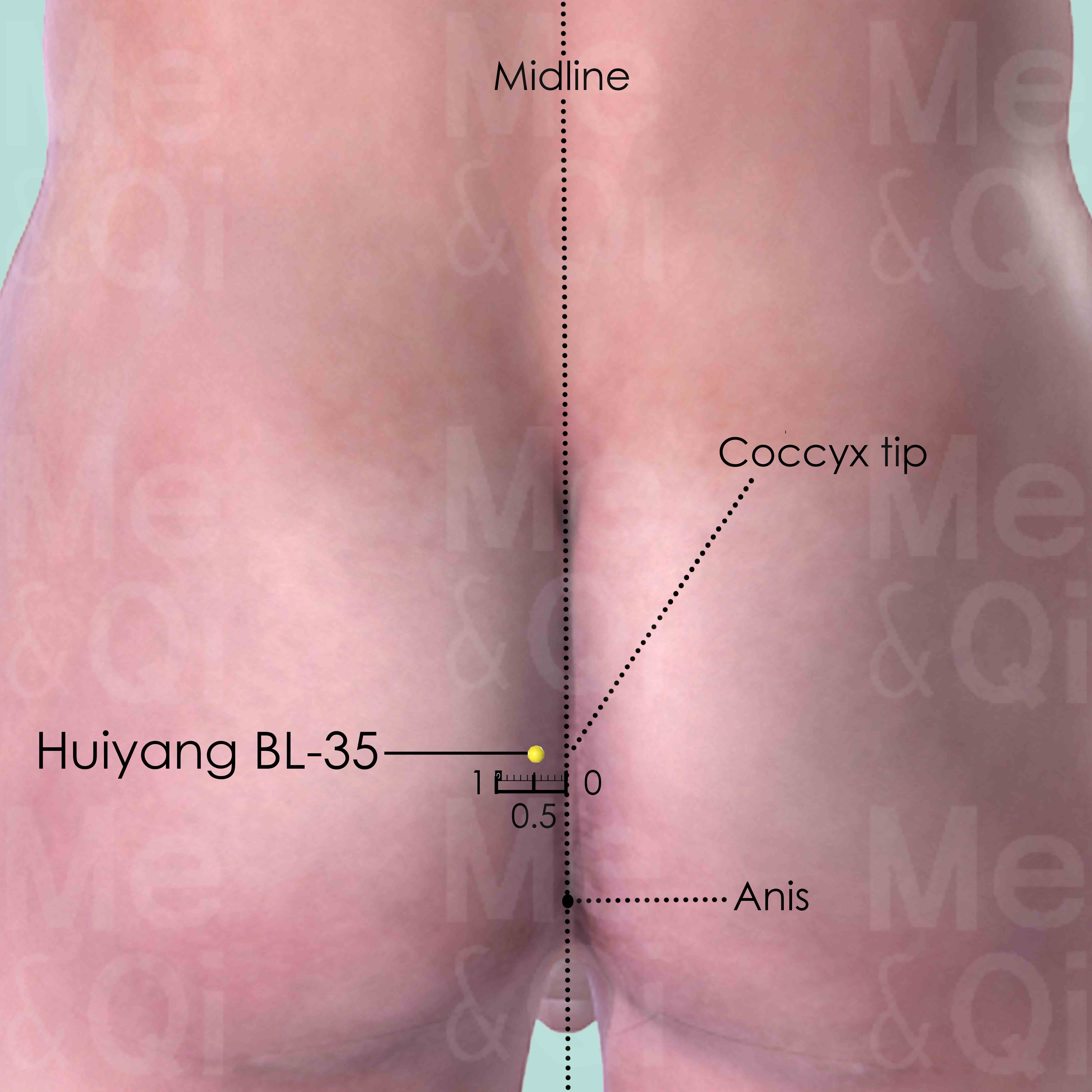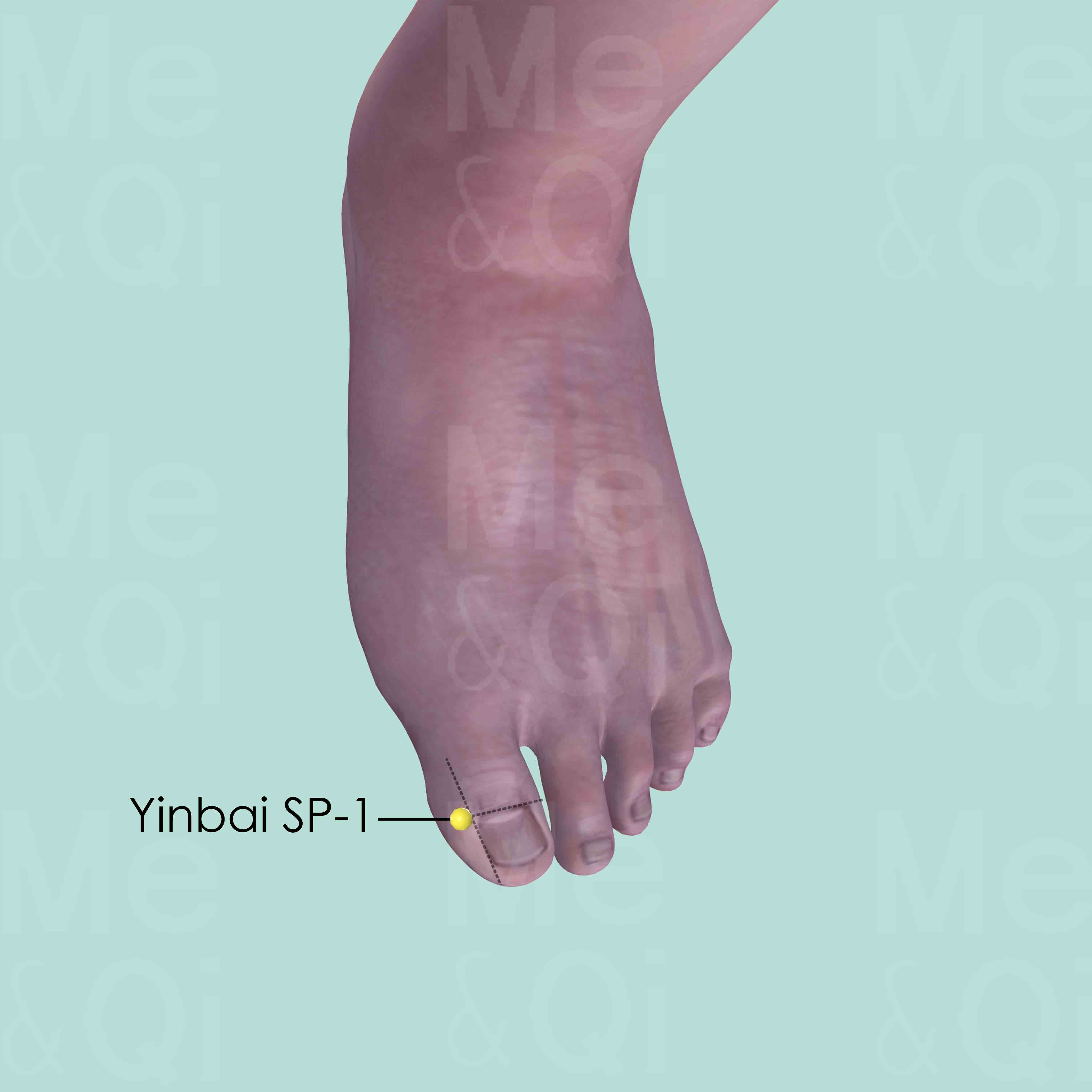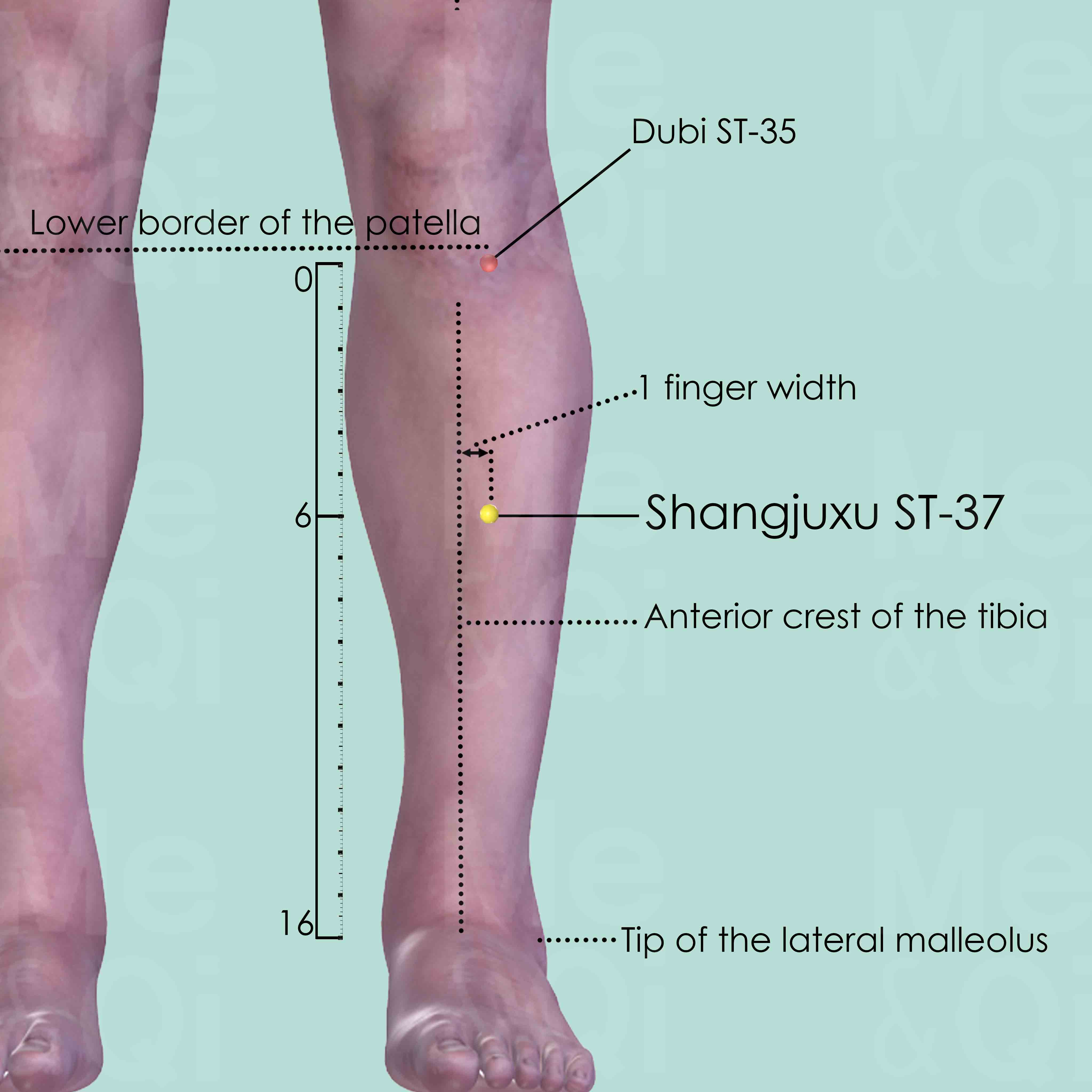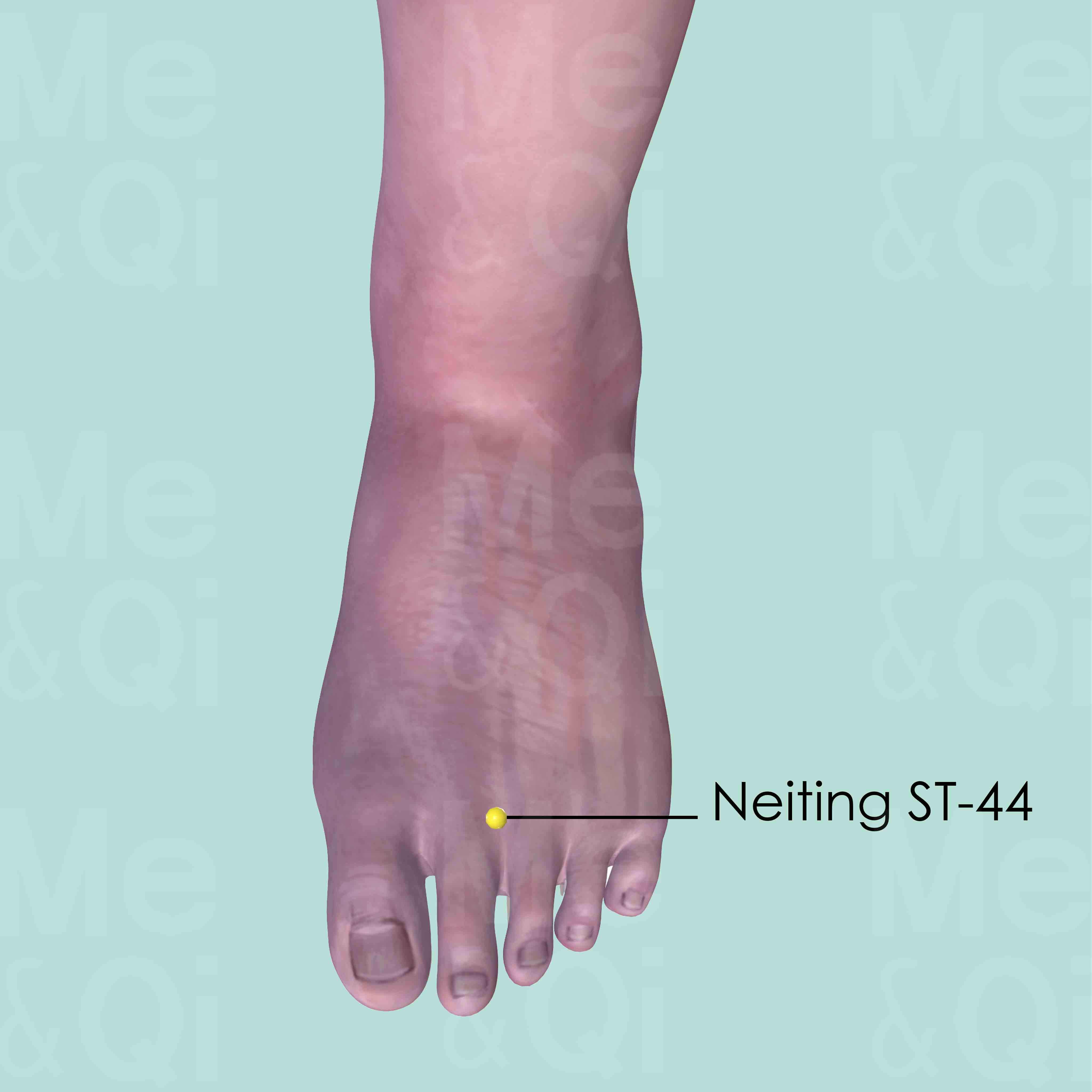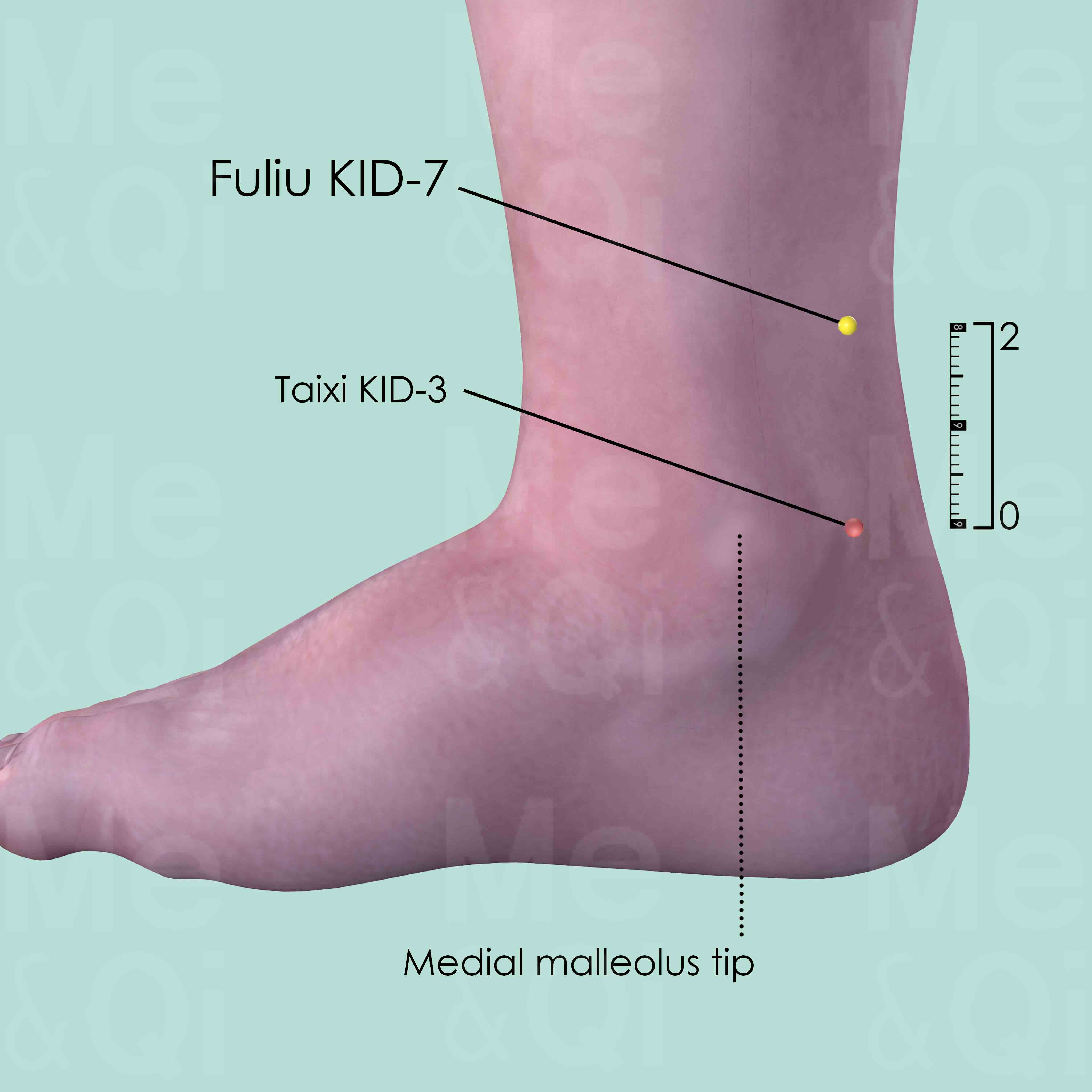Hematocheziaaccording to TCM
Symptom family: Stool and Bowel Irregularities
Sub-symptom(s): Chronic Hematochezia Dark Blood In Stool
What is Hematochezia?
Hematochezia, a medical term for blood in stool, signifies a condition where there is visible red to dark blood present in bowel movements. This symptom can point to a variety of underlying conditions ranging from minor issues like hemorrhoids to more serious conditions such as colorectal cancer.
Chronic hematochezia refers to a persistent presence of blood in the feces, indicating a possible ongoing digestive tract problem. Understanding hematochezia is crucial for diagnosing and treating the underlying cause effectively.
How does TCM view Hematochezia?
In Traditional Chinese Medicine (TCM), hematochezia is viewed through the lens of imbalance and disharmony within the body's organ systems and energy pathways. TCM does not simply see it as a symptom but as a signal of deeper issues related to the flow of Qi (vital energy), Blood, and the balance of some Organs.
Conditions such as Damp-Heat in the Large Intestine or Blood Heat are often considered underlying causes, each requiring a unique approach to restore balance and health.
Root Causes of Hematochezia in TCM
TCM identifies several patterns that can lead to hematochezia, focusing on internal Heat and Blood disharmony as primary causes. Damp-Heat in the Large Intestine, for instance, is characterized by symptoms like bloody stools, abdominal pain, and a sense of fullness, alongside the presence of mucus and a burning sensation at the anus.
Another pattern, Heat in the Blood, manifests through symptoms such as frequent bleeding, thirst, and the occurrence of red skin eruptions alongside bloody stools. These patterns suggest an excess of heat within the body, disrupting the normal function of the intestines and damaging the blood vessels therein.
Explore below more details about what might cause Hematochezia according to TCM.
- By Syndrome
- By Organ
- Heat
- Mind Disturbance
- Blood Deficiency
- Blood Stasis
- Yang Deficiency
- Dampness
- Cold
- View More Causes
- Large Intestine
- Stomach
- Kidney
- Spleen
- View More Organs
Heat
In TCM "Heat" signifies an excess of Yang energy, leading to an imbalance where heat predominates over the body's cool Yin aspects. This condition is metaphorically akin to an internal over-heating. Symptoms indicative of Heat can include feelings of warmth, fever, sweating, irritability, red face, thirst with a preference for cold drinks, and a rapid pulse. The tongue may appear red with a yellow coating. Unlike the common interpretation of heat in terms of temperature, in TCM, it represents a state of hyperactivity or inflammation in the body.... see more
Heat Patterns That Can Lead to Hematochezia
Common Symptoms: Abdominal Pain Fever Feeling Hot Thirst Hematuria Vomiting Blood Nosebleeds Restlessness
| Pattern Name | Relevant Symptoms | Relevant Formulas |
|---|---|---|
| Damp-Heat in the Large Intestine | Bloody stools, Abdominal pain, Abdominal fullness, Diarrhea, Hematochezia, Mucous in feces, Smelly stools, Anal burning, Scanty and dark urine, Fever, Perspiration, Feeling hot, Thirst, Feeling of heaviness... see more | Ge Geng Huang Qin Huang Lian Tang | Shao Yao Tang |
| Heat in the Blood | Bloody stools, Feeling hot, Red skin eruptions, Thirst, Frequent bleeding, Bloody sputum, Hematochezia, Hematuria, Vomiting blood, Hemoptysis, Nosebleeds, Excessive menstruation... see more | Xi Jiao Di Huang Tang | Gu Jing Wan | Shi Hui San | Bai He Di Huang Tang | Hua Ban Tang | Qing Ying Tang | Qing Re Gu Jing Tang |
| Heat victorious agitating Blood | Bloody stools, Restlessness, High fever, Mania, Macules, Vomiting blood, Nosebleeds, Hematochezia, Hematuria... see more | Xi Jiao Di Huang Tang |
Mind Disturbance
In TCM "Shen" refers to the mind or spirit, and a Shen disturbance is a pattern of disharmony that affects the mental and emotional state. This concept reflects the TCM belief in the deep interconnectedness of mind and body. Symptoms of Shen disturbance can vary widely but often include anxiety, insomnia, restlessness, confusion, or in severe cases, hallucinations or delirium. These symptoms indicate an imbalance in the body's energies affecting the heart, which in TCM is not only the center of blood circulation but also the seat of the mind and consciousness. The root of Shen disturbance can be traced to various factors, including emotional stress, physical illness, or an imbalance in fundamental substances like Qi, Yin, or Yang.... see more
Mind Disturbance Patterns That Can Lead to Hematochezia
| Pattern Name | Relevant Symptoms | Relevant Formulas |
|---|---|---|
| Heat victorious agitating Blood | Bloody stools, Restlessness, High fever, Mania, Macules, Vomiting blood, Nosebleeds, Hematochezia, Hematuria... see more | Xi Jiao Di Huang Tang |
Blood Deficiency
Blood Deficiency in TCM is like when your body's tank runs low on the vital energy that blood provides. It's not exactly the same as anemia in modern medicine, which is about having too few red blood cells. Instead, Blood Deficiency in TCM is about your body not having enough of the life-giving qualities that blood brings, like nourishment and moisture. This can make you feel tired, look pale, and even feel dizzy or have blurry vision. It's like a garden not getting enough water to stay lush and vibrant. TCM sees this as an imbalance where the body isn't being nourished as it should be, impacting overall health and well-being.... see more
Blood Deficiency Patterns That Can Lead to Hematochezia
| Pattern Name | Relevant Symptoms | Relevant Formulas |
|---|---|---|
| Loss of Blood | Bloody stools, Nosebleeds, Uterine hemorrhage, Hematuria, Hematochezia, Hemoptysis, Vomiting blood, Dark menstrual clots, Excessive menstruation, Bloody sputum... see more | Xi Jiao Di Huang Tang |
Blood Stasis
Blood Stasis in TCM is a concept where the blood flow in the body is not as smooth or efficient as it should be. Imagine a river that's supposed to flow freely, but instead, it's getting blocked or moving too slowly in some parts. This can lead to various health issues, like pain that feels sharp or stabbing, dark bruises, and a complexion that looks purplish. TCM believes that good health relies on the smooth and vibrant flow of Qi and blood throughout the body, so when blood gets stuck, it's like a traffic jam in your body, leading to discomfort or health problems.... see more
Blood Stasis Patterns That Can Lead to Hematochezia
| Pattern Name | Relevant Symptoms | Relevant Formulas |
|---|---|---|
| Stomach Blood Stagnation | Bloody stools, Nocturnal epigastric pain, Abdominal pain worsened by pressure, Nausea or vomiting, Potential vomiting of blood, Hematochezia... see more | Shi Xiao San | Ge Xia Zhu Yu Tang |
Yang Deficiency
Yang deficiency in TCM refers to a state where the body's Yang energy, which is responsible for warmth, activity, and function, is weakened or diminished. This pattern of disharmony often arises from chronic illness, aging, or inherent constitutional weakness. Symptoms of Yang deficiency are typically associated with cold and sluggishness, such as a feeling of coldness, cold extremities, pale complexion, low energy or fatigue, and a desire for warmth. Digestive issues like poor appetite, loose stools, and water retention can also be indicative of Yang deficiency.... see more
Yang Deficiency Patterns That Can Lead to Hematochezia
| Pattern Name | Relevant Symptoms | Relevant Formulas |
|---|---|---|
| Kidney and Spleen Yang Deficiency with Empty Cold | Dark blood in stool, Chronic dysentery, Mucous in feces, Abdominal pain relieved by pressure and warmth... see more | Tao Hua Tang |
Dampness
"Dampness" in TCM is a concept that describes a pattern of disharmony where the body accumulates excess moisture. Imagine the heavy, sticky feeling you get on a very humid day; that's similar to what dampness feels like internally. It can manifest as a sense of heaviness, bloating, sluggishness, or even a foggy mind. This condition is often thought to arise from environmental factors like living in a damp place, dietary habits that promote moisture in the body, or internal imbalances that hinder the body's ability to process fluids properly. In TCM, dampness can obstruct the normal flow of energy and fluids in the body, leading to various symptoms.... see more
Dampness Patterns That Can Lead to Hematochezia
| Pattern Name | Relevant Symptoms | Relevant Formulas |
|---|---|---|
| Damp-Heat in the Large Intestine | Bloody stools, Abdominal pain, Abdominal fullness, Diarrhea, Hematochezia, Mucous in feces, Smelly stools, Anal burning, Scanty and dark urine, Fever, Perspiration, Feeling hot, Thirst, Feeling of heaviness... see more | Ge Geng Huang Qin Huang Lian Tang | Shao Yao Tang |
Cold
In TCM "Cold" as a pattern of disharmony refers to a specific type of imbalance within the body's systems, often linked to a deficiency or weakness. It's not about feeling physically cold or having a common cold, but rather a metaphorical description of certain symptoms and underlying conditions. When a TCM practitioner says someone suffers from "Cold," it usually implies that the body's Yang energy, which is warm and active, is insufficient or overpowered by Yin energy, which is cool and passive. Symptoms of Cold in TCM can include a general feeling of coldness, cold limbs, pale complexion, low energy, slow metabolism, and a preference for warmth. ... see more
Cold Patterns That Can Lead to Hematochezia
| Pattern Name | Relevant Symptoms | Relevant Formulas |
|---|---|---|
| Kidney and Spleen Yang Deficiency with Empty Cold | Dark blood in stool, Chronic dysentery, Mucous in feces, Abdominal pain relieved by pressure and warmth... see more | Tao Hua Tang |
Large Intestine
In TCM the Large Intestine is primarily seen as responsible for the absorption of fluids and the excretion of waste. It is closely related to the Lung in terms of energy flow and function, reflecting the interconnectedness of organ systems in TCM. When the Large Intestine malfunctions, it can lead to issues such as constipation or diarrhea, abdominal pain, and an inability to let go of emotional waste, like holding onto grief or stress. This is in line with the TCM view that the physical and emotional aspects of health are deeply connected. An imbalanced Large Intestine can also manifest as skin problems, signifying the organ’s role in eliminating toxins and maintaining balance in the body’s internal environment.... see more
Large Intestine Patterns That Can Lead to Hematochezia
| Pattern Name | Relevant Symptoms | Relevant Formulas |
|---|---|---|
| Damp-Heat in the Large Intestine | Bloody stools, Abdominal pain, Abdominal fullness, Diarrhea, Hematochezia, Mucous in feces, Smelly stools, Anal burning, Scanty and dark urine, Fever, Perspiration, Feeling hot, Thirst, Feeling of heaviness... see more | Ge Geng Huang Qin Huang Lian Tang | Shao Yao Tang |
Stomach
In TCM the Stomach is regarded as the "sea of nourishment," pivotal for digesting food and transforming it into Qi and blood. It works closely with the Spleen to distribute these essential nutrients throughout the body. When the Stomach is out of balance or malfunctions in TCM, it often leads to digestive problems such as bloating, nausea, vomiting, poor appetite, or a feeling of fullness. There may also be issues like acid reflux or a sour taste in the mouth. Emotionally, an imbalanced Stomach can contribute to excessive worry and overthinking, reflecting the TCM belief that physical and emotional well-being are deeply interconnected.... see more
Stomach Patterns That Can Lead to Hematochezia
| Pattern Name | Relevant Symptoms | Relevant Formulas |
|---|---|---|
| Stomach Blood Stagnation | Bloody stools, Nocturnal epigastric pain, Abdominal pain worsened by pressure, Nausea or vomiting, Potential vomiting of blood, Hematochezia... see more | Shi Xiao San | Ge Xia Zhu Yu Tang |
Kidney
In TCM the Kidneys are regarded as the body's most fundamental reservoir of Essence, known as Jing, which influences growth, reproduction, and aging. They are not just organs for filtering blood, but a holistic system governing vital life forces. When the Kidneys malfunction in TCM, it can manifest as a variety of health issues, such as chronic fatigue, reproductive problems, imbalances in fluid metabolism leading to edema or dryness, lower back pain, and a sense of fear or insecurity.... see more
Kidney Patterns That Can Lead to Hematochezia
| Pattern Name | Relevant Symptoms | Relevant Formulas |
|---|---|---|
| Kidney and Spleen Yang Deficiency with Empty Cold | Dark blood in stool, Chronic dysentery, Mucous in feces, Abdominal pain relieved by pressure and warmth... see more | Tao Hua Tang |
Spleen
In TCM the Spleen plays a vital role in digestion and transformation, converting food into energy and nutrients, and overseeing the distribution of Qi and Blood. It's also crucial in maintaining the health of muscles and limbs and ensuring the blood remains within the vessels. When the Spleen malfunctions in TCM, it can lead to a variety of issues such as digestive disorders, fatigue, weak muscles, bloating, and a feeling of heaviness. It can also cause a pale complexion, poor appetite, and a tendency to bruise easily. Emotionally, a Spleen imbalance is often associated with excessive worry or overthinking, reflecting its role in the interplay between physical and mental health.... see more
Spleen Patterns That Can Lead to Hematochezia
| Pattern Name | Relevant Symptoms | Relevant Formulas |
|---|---|---|
| Kidney and Spleen Yang Deficiency with Empty Cold | Dark blood in stool, Chronic dysentery, Mucous in feces, Abdominal pain relieved by pressure and warmth... see more | Tao Hua Tang |
TCM Herbal Formulas for Hematochezia
To address hematochezia, TCM recommends formulas that target the underlying patterns of disharmony. For conditions marked by Damp-Heat in the Large Intestine, Ge Geng Huang Qin Huang Lian Tang, which includes Kudzu Roots, is used to clear internal Heat and resolve Dampness.
In cases where Blood Heat is the root cause, Xi Jiao Di Huang Tang, featuring Water Buffalo Horns, is prescribed to cool the blood and stop the bleeding. These formulas exemplify TCM's holistic approach, aiming not only to alleviate the symptom but also to correct the internal imbalances leading to hematochezia.
Explore below some TCM herbal formulas used to address hematochezia, organized by cause and by formula type.
- By Cause
- By Formula Type
- Heat
- Mind Disturbance
- Blood Deficiency
- Blood Stasis
- Yang Deficiency
- Dampness
- Cold
- View More Causes
- Formulas that clear nutritive-level heat
- Formulas that clear heat from deficiency
- Formulas that invigorate blood and dispel blood stagnation
- Formulas that release the exterior and clear the interior
- Formulas that clear heat from the organs
- Formulas that secure irregular uterine bleeding and stop vaginal discharge
- Formulas that stop bleeding
- Formulas that clear heat from qi and blood
- Formulas that tonify qi and blood
- Formulas that bind up intestines and secure abandoned conditions
Top Formula for Heat:
Xi Jiao Di Huang Tang
Suitable for Heat patterns that may cause hematochezia, such as Heat in the Blood or Heat victorious agitating Blood
Learn moreAll Formulas Recommended for Hematochezia Caused by Heat
| Formula | Patterns Suitable For |
|---|---|
| Xi Jiao Di Huang Tang | Heat in the Blood, Heat victorious agitating Blood |
| Ge Geng Huang Qin Huang Lian Tang | Damp-Heat in the Large Intestine |
| Shao Yao Tang | Damp-Heat in the Large Intestine |
| Gu Jing Wan | Heat in the Blood |
| Shi Hui San | Heat in the Blood |
| Bai He Di Huang Tang | Heat in the Blood |
| Hua Ban Tang | Heat in the Blood |
| Qing Ying Tang | Heat in the Blood |
| Qing Re Gu Jing Tang | Heat in the Blood |
Top Formula for Mind Disturbance:
Xi Jiao Di Huang Tang
Suitable for Mind Disturbance patterns that may cause hematochezia, such as Heat victorious agitating Blood
Learn moreTop Formula for Blood Deficiency:
Xi Jiao Di Huang Tang
Suitable for Blood Deficiency patterns that may cause hematochezia, such as Loss of Blood
Learn moreTop Formula for Blood Stasis:
Shi Xiao San
Suitable for Blood Stasis patterns that may cause hematochezia, such as Stomach Blood Stagnation
Learn moreAll Formulas Recommended for Hematochezia Caused by Blood Stasis
| Formula | Patterns Suitable For |
|---|---|
| Shi Xiao San | Stomach Blood Stagnation |
| Ge Xia Zhu Yu Tang | Stomach Blood Stagnation |
Top Formula for Yang Deficiency:
Tao Hua Tang
Suitable for Yang Deficiency patterns that may cause hematochezia, such as Kidney and Spleen Yang Deficiency with Empty Cold
Learn moreTop Formula for Dampness:
Ge Geng Huang Qin Huang Lian Tang
Suitable for Dampness patterns that may cause hematochezia, such as Damp-Heat in the Large Intestine
Learn moreAll Formulas Recommended for Hematochezia Caused by Dampness
| Formula | Patterns Suitable For |
|---|---|
| Ge Geng Huang Qin Huang Lian Tang | Damp-Heat in the Large Intestine |
| Shao Yao Tang | Damp-Heat in the Large Intestine |
Top Formula for Cold:
Tao Hua Tang
Suitable for Cold patterns that may cause hematochezia, such as Kidney and Spleen Yang Deficiency with Empty Cold
Learn moreFormulas that clear nutritive-level Heat
These formulas are suitable for some hematochezia-causing patterns like Heat in the Blood or Heat victorious agitating Blood.
One such formula is Xi Jiao Di Huang Tang, with water buffalo horn as a key herb.
Other formulas of this category are listed in the table below.
All "formulas that clear nutritive-level heat" recommended for hematochezia
| Formula | Patterns Suitable For (if applicable) |
|---|---|
| Xi Jiao Di Huang Tang | Heat in the Blood, Heat victorious agitating Blood, Loss of Blood |
| Qing Ying Tang | Heat in the Blood |
Formulas that clear Heat from Deficiency
These formulas are suitable for some hematochezia-causing patterns like Heat in the Blood.
One such formula is Bai He Di Huang Tang, with lily bulb as a key herb.
Other formulas of this category are listed in the table below.
All "formulas that clear heat from deficiency" recommended for hematochezia
| Formula | Patterns Suitable For (if applicable) |
|---|---|
| Bai He Di Huang Tang | Heat in the Blood |
| Qing Re Gu Jing Tang | Heat in the Blood |
Formulas that invigorate Blood and dispel Blood Stagnation
These formulas are suitable for some hematochezia-causing patterns like Stomach Blood Stagnation.
One such formula is Shi Xiao San, with cattail pollen as a key herb.
Other formulas of this category are listed in the table below.
All "formulas that invigorate blood and dispel blood stagnation" recommended for hematochezia
| Formula | Patterns Suitable For (if applicable) |
|---|---|
| Shi Xiao San | Stomach Blood Stagnation |
| Ge Xia Zhu Yu Tang | Stomach Blood Stagnation |
Formulas that Release the Exterior and Clear the Interior
These formulas are suitable for some hematochezia-causing patterns like Damp-Heat in the Large Intestine.
One such formula is Ge Geng Huang Qin Huang Lian Tang, with kudzu root as a key herb.
Formulas that clear Heat from the Organs
These formulas are suitable for some hematochezia-causing patterns like Damp-Heat in the Large Intestine.
One such formula is Shao Yao Tang, with goldthread rhizome as a key herb.
Formulas that secure irregular uterine bleeding and stop vaginal discharge
These formulas are suitable for some hematochezia-causing patterns like Heat in the Blood.
One such formula is Gu Jing Wan, with tortoise plastron as a key herb.
Formulas that stop bleeding
These formulas are suitable for some hematochezia-causing patterns like Heat in the Blood.
One such formula is Shi Hui San, with japanese thistle as a key herb.
Formulas that clear Heat from Qi and Blood
These formulas are suitable for some hematochezia-causing patterns like Heat in the Blood.
One such formula is Hua Ban Tang, with gypsum as a key herb.
Formulas that tonify Qi and Blood
These formulas are suitable for some hematochezia-causing patterns like Spleen not controlling Blood.
One such formula is Gui Pi Tang, with ginseng as a key herb.
Formulas that bind up Intestines and secure abandoned conditions
These formulas are suitable for some hematochezia-causing patterns like Kidney and Spleen Yang Deficiency with Empty Cold.
One such formula is Tao Hua Tang, with red halloysite as a key herb.
Acupoints for Hematochezia
TCM also employs acupuncture as part of the treatment strategy for hematochezia. Key acupoints include Dachangshu (BL-25) to regulate the Large Intestine and remove Qi Stagnation, and Sanyinjiao (SP-6) to tonify the Spleen and Stomach, resolve dampness, and nourish the Blood.
These points, along with others like Shangjuxu (ST-37) to regulate the intestines, are selected based on the individual's specific pattern of disharmony, providing a targeted approach to treating hematochezia and restoring health.
Explore below some acupoints used to address hematochezia, organized by meridian.
- By Meridian
- Bladder Channel
- Spleen Channel
- Stomach Channel
- Large Intestine Channel
- Extra Points: Upper Extremities (EX-UE)
- Kidney Channel
- Governing Vessel
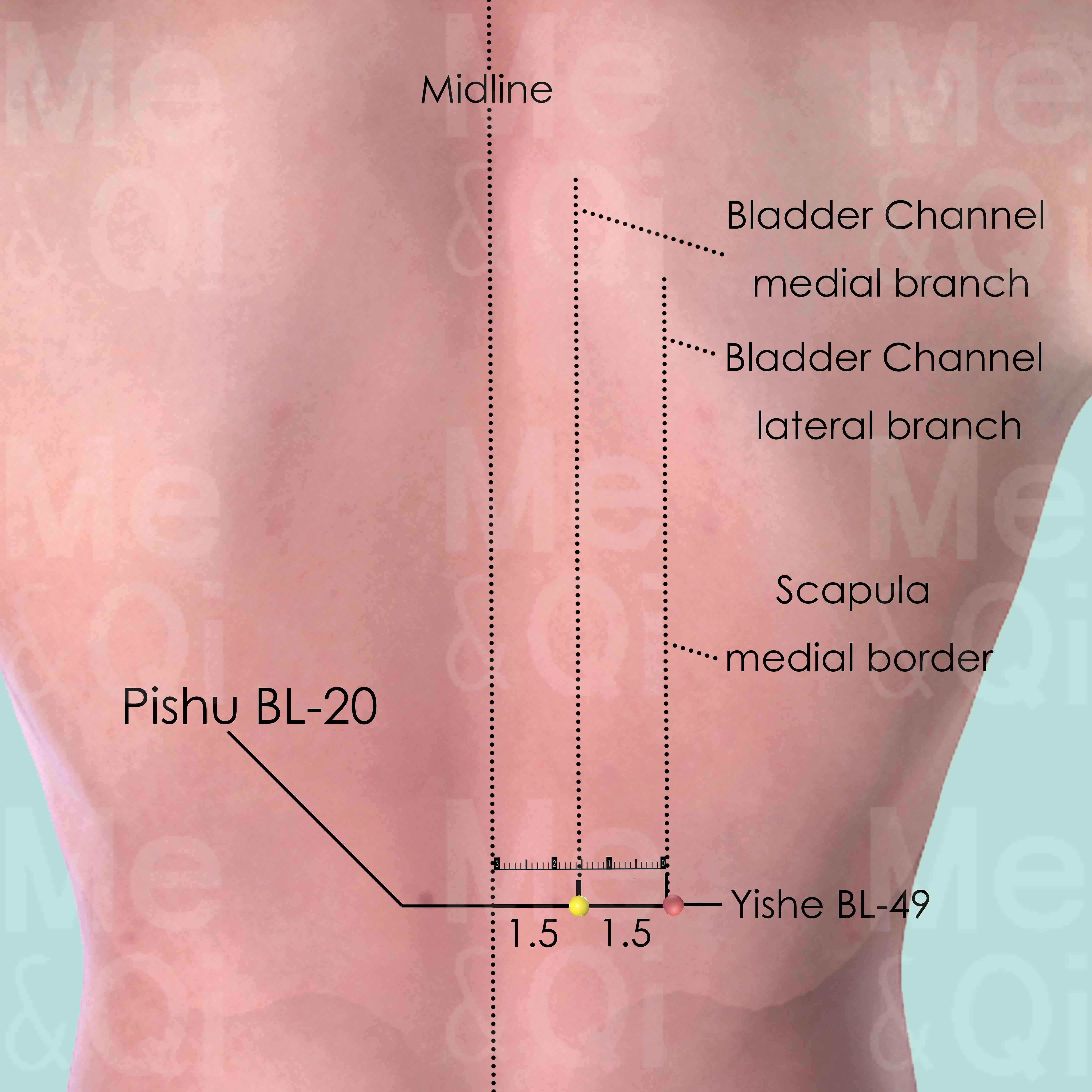
Pishu BL-20
1.5 cun lateral to the lower border of the spinous process of the 11th thoracic vertebra (T11).
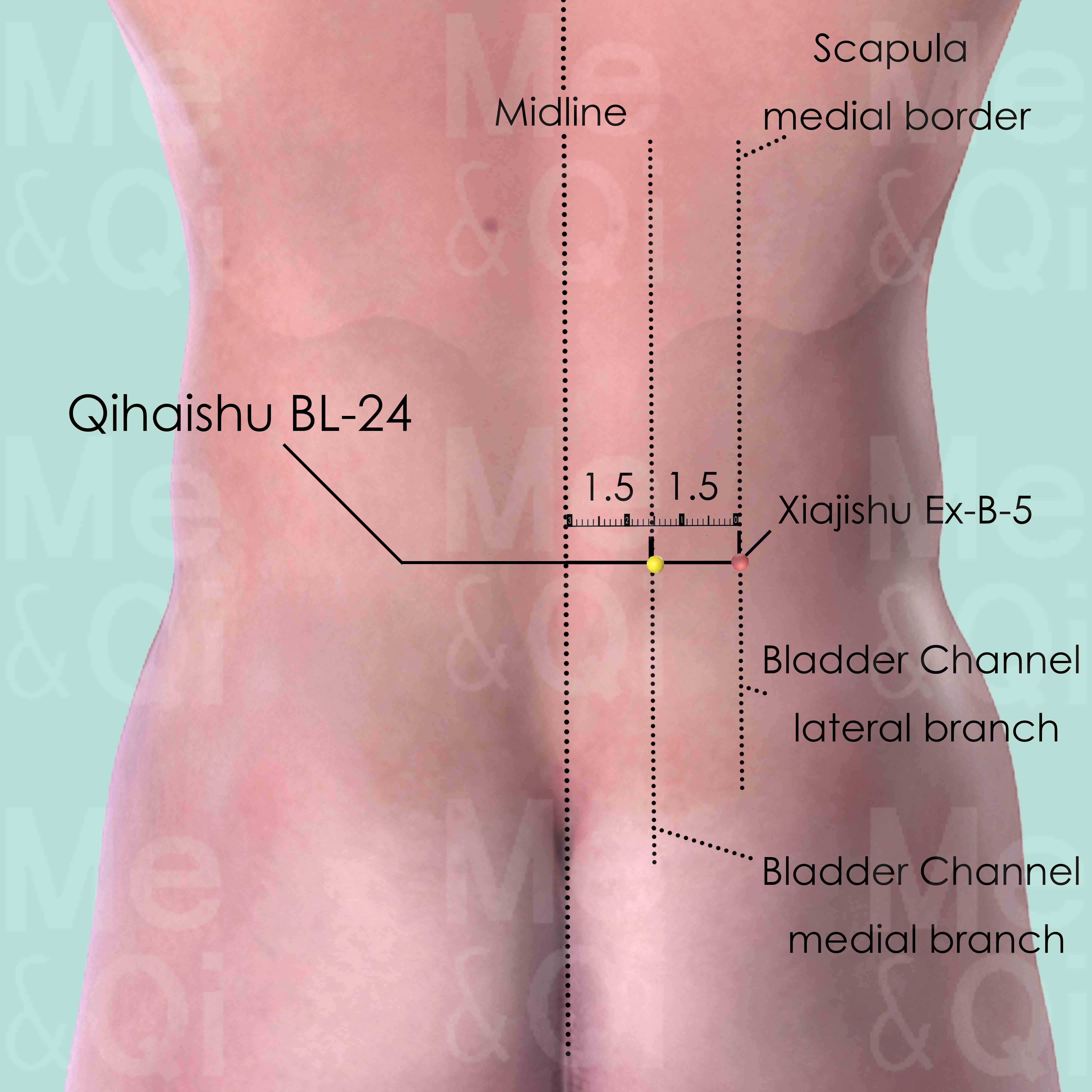
Qihaishu BL-24
1.5 cun lateral to the lower border of the spinous process of the 3rd lumber vertebra (L3).
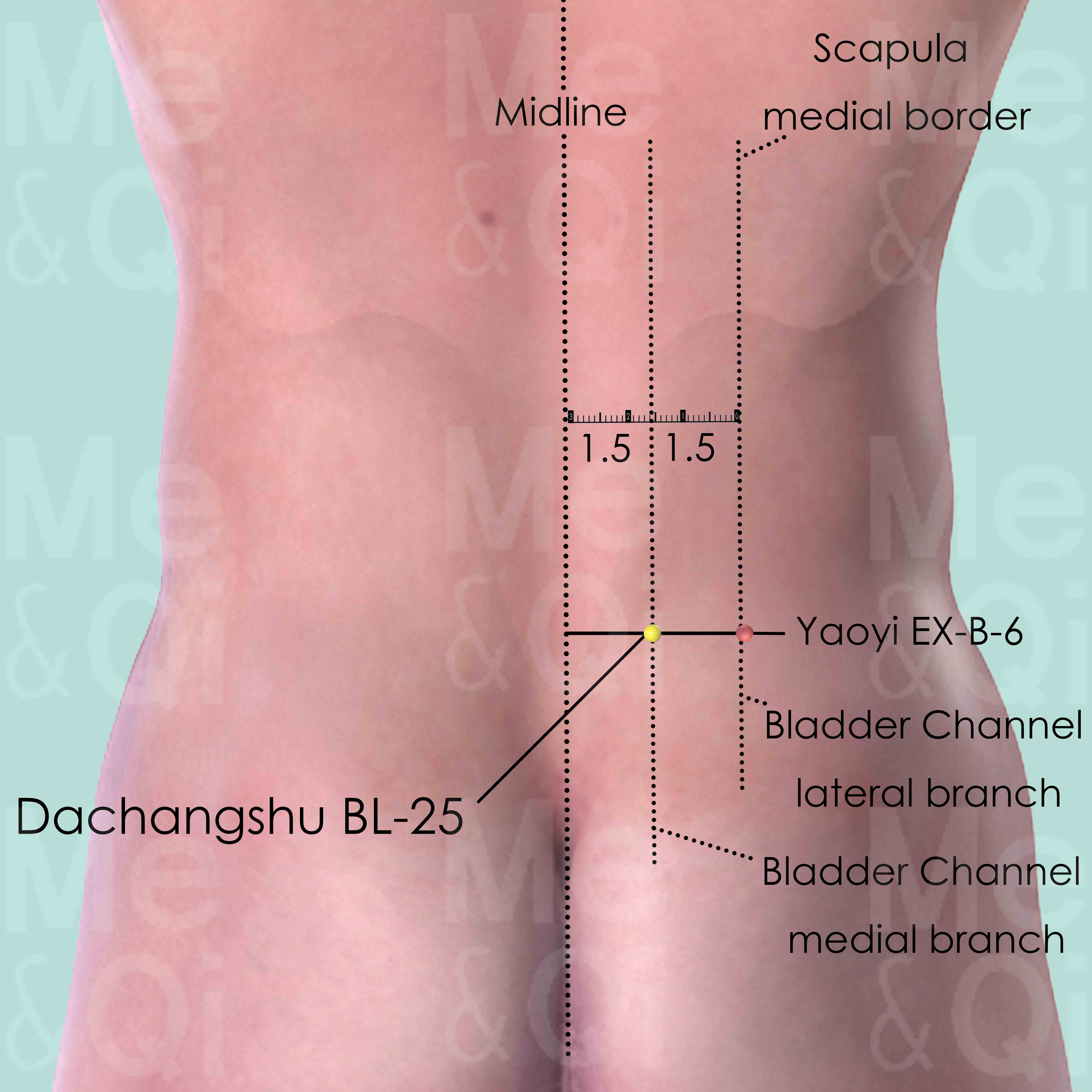
Dachangshu BL-25
1.5 cun lateral to the lower border of the spinous process of the 4th lumber vertebra (L4).
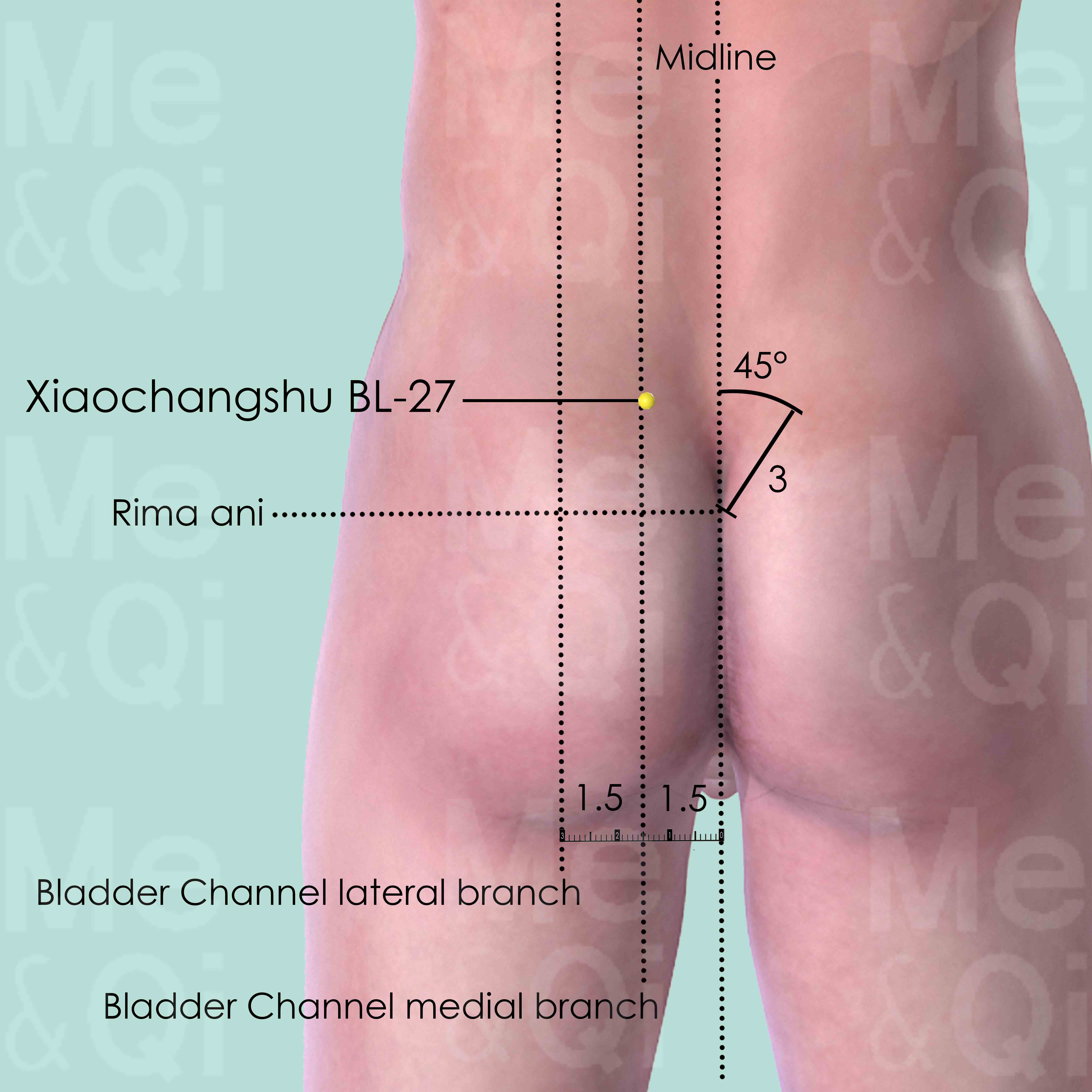
Xiaochangshu BL-27
At the level of the 1st posterior sacral foramen, 1.5 cun lateral to the posterior midline.
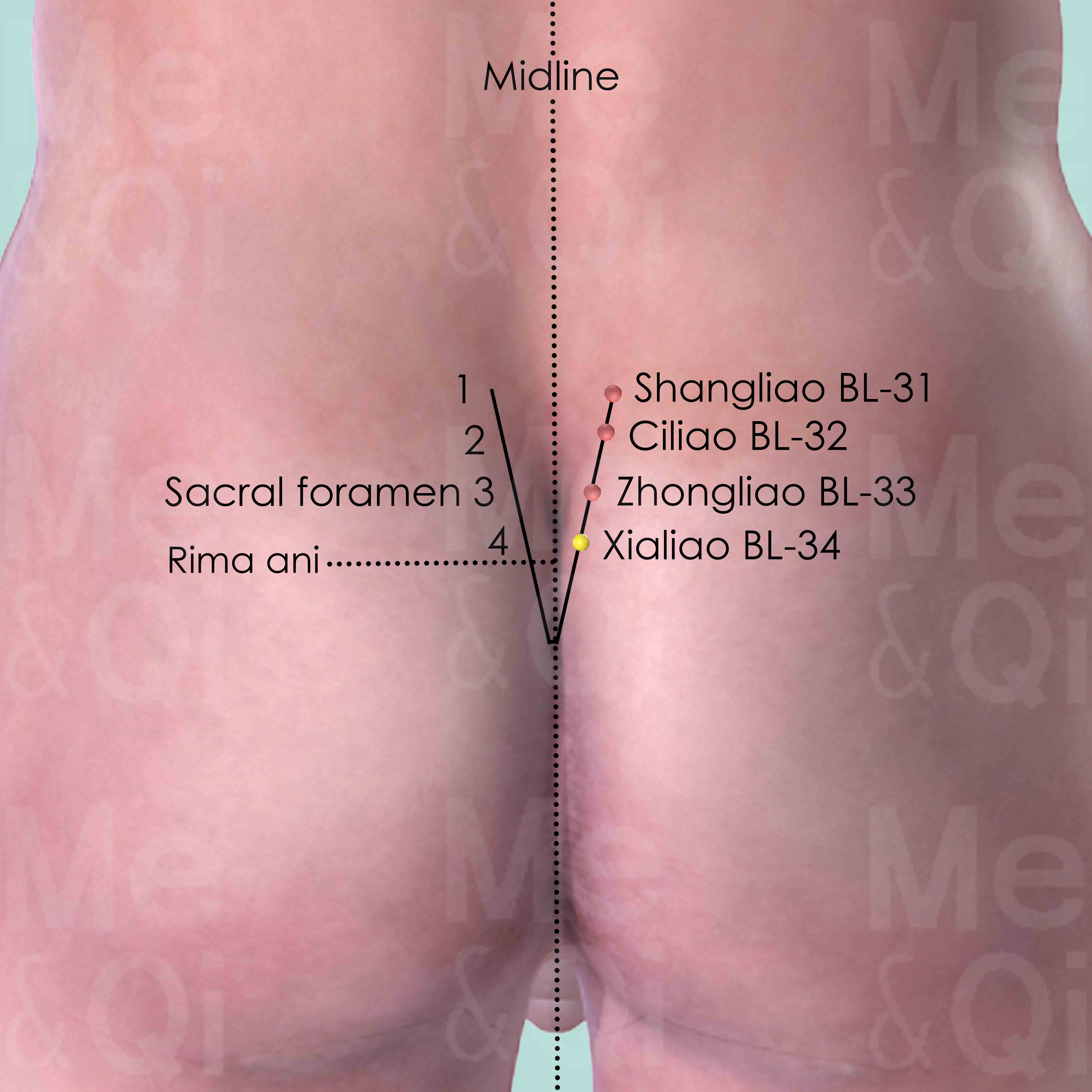
Xialiao BL-34
In the 4th posterior sacral foramen, between the posterior superior iliac spine and the midline.
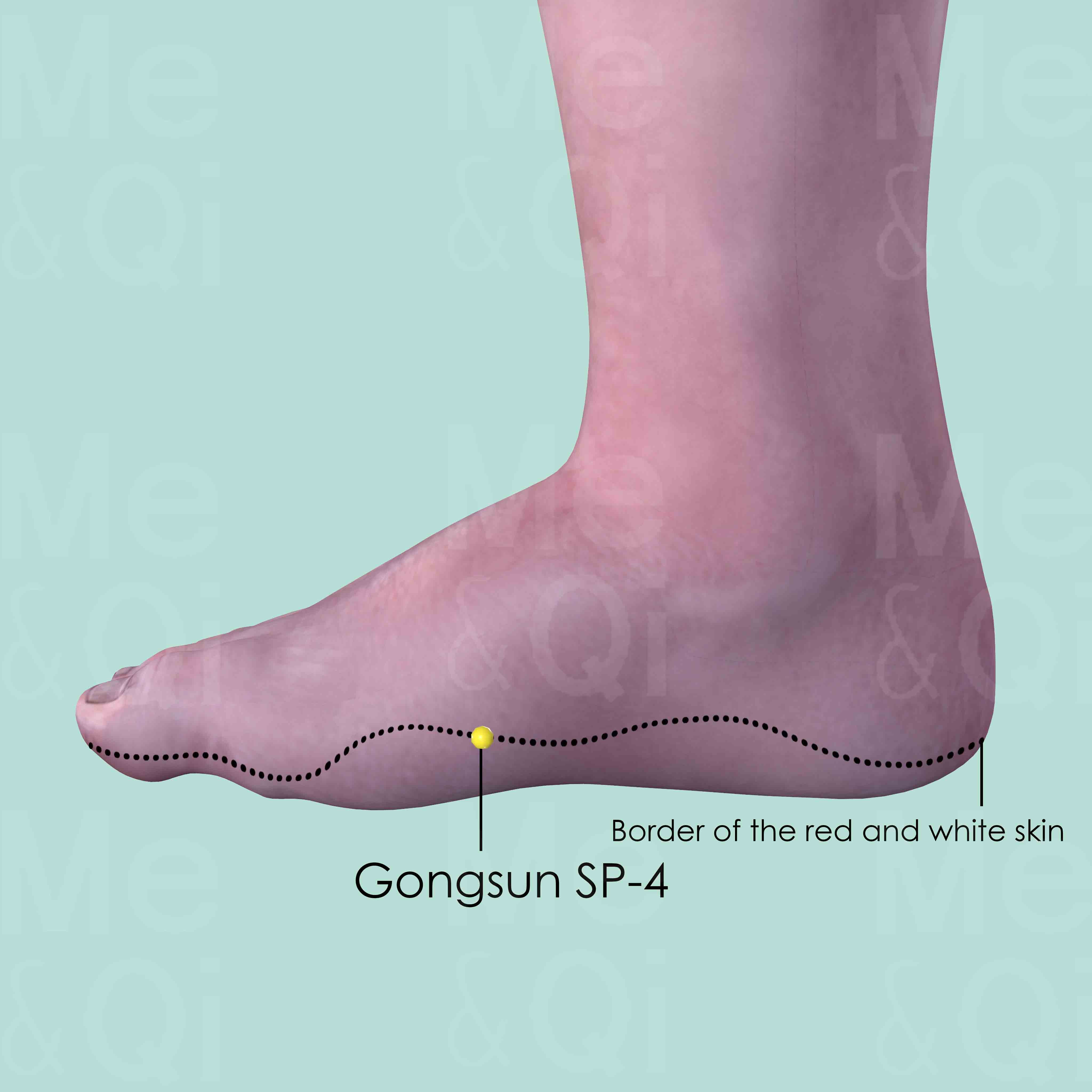
Gongsun SP-4
In the depression distal and inferior to the base of the 1st metatarsal bone, at the border of the red and white skin.
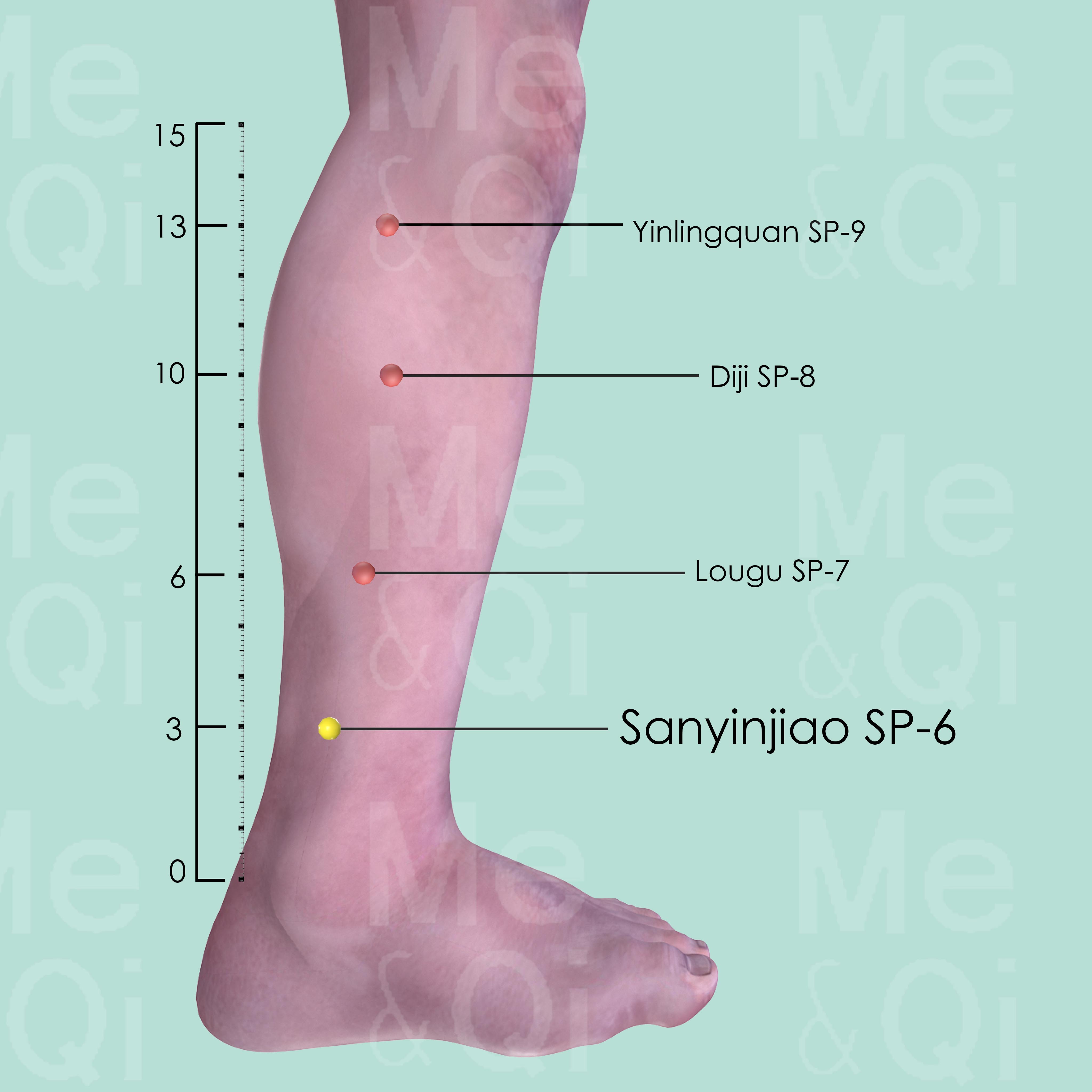
Sanyinjiao SP-6
3 cun directly above the tip of the medial malleolus, on the posterior border of the tibia, on the line drawn from the medial malleolus to Yinlingquan SP-9.
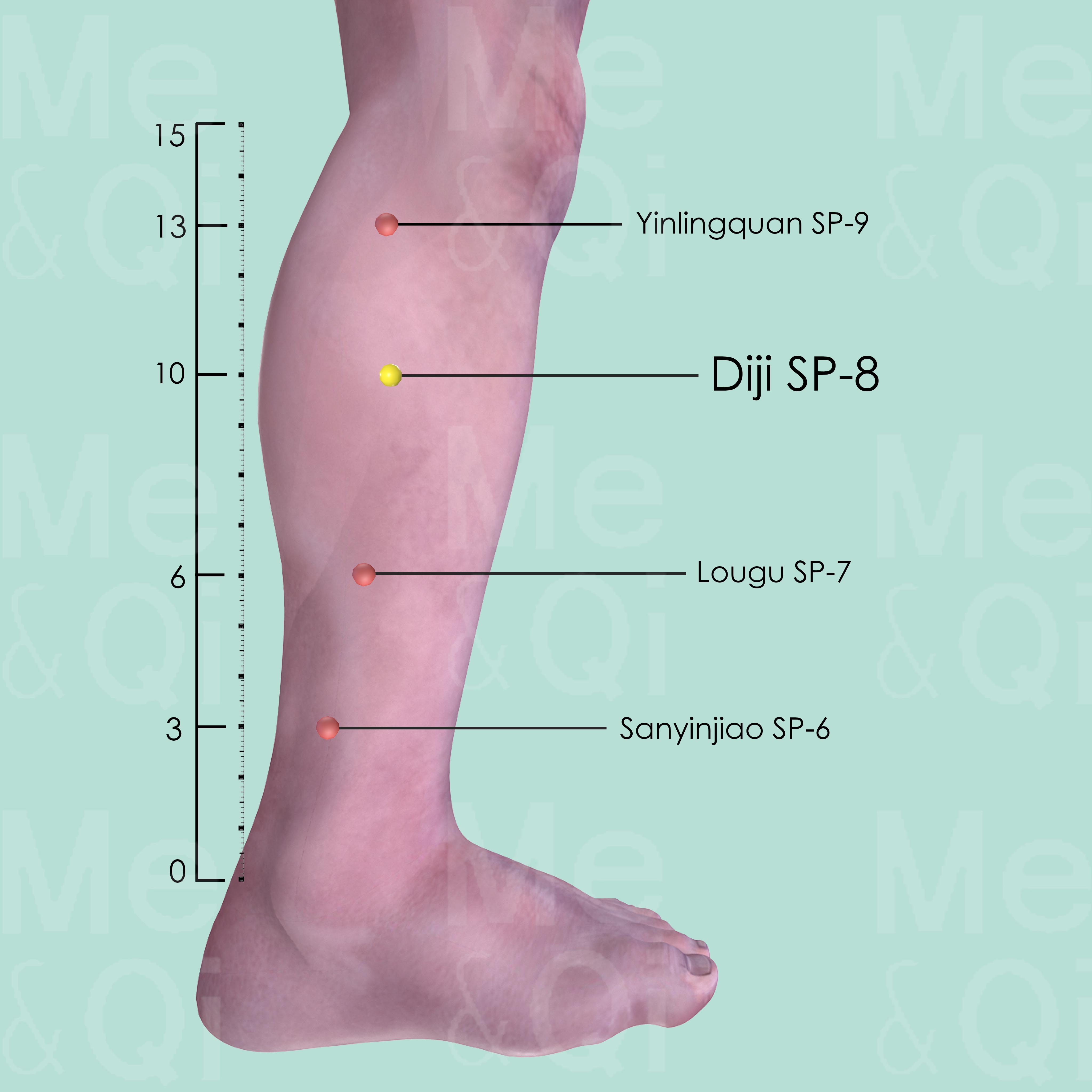
Diji SP-8
3 cun below the medial condyle of the tibia, on the line connecting Yinlingquan SP-9 and the the medial malleolus.
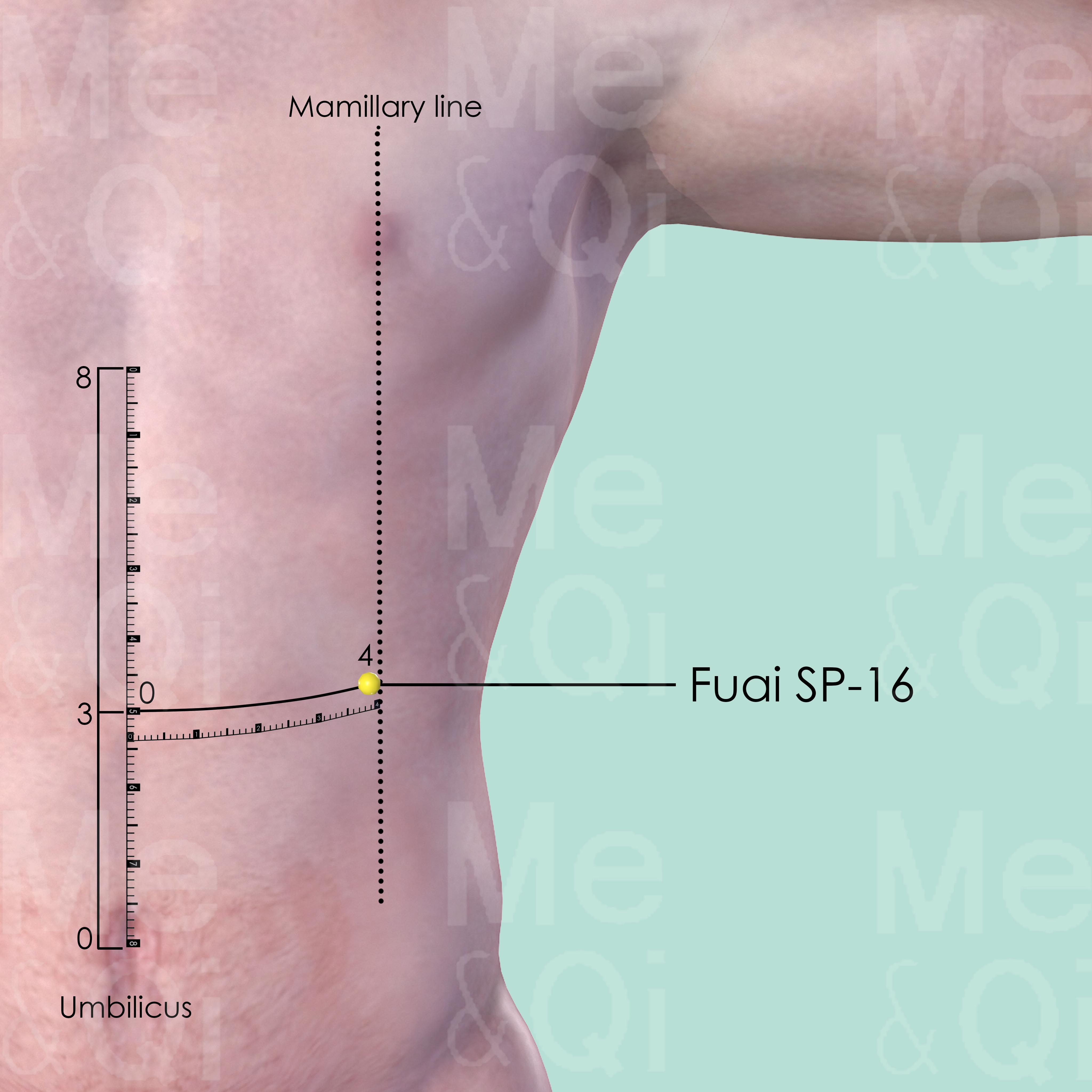
Fuai SP-16
3 cun above the umbilicus center and 4 cun lateral to the anterior midline, on the mamillary line.
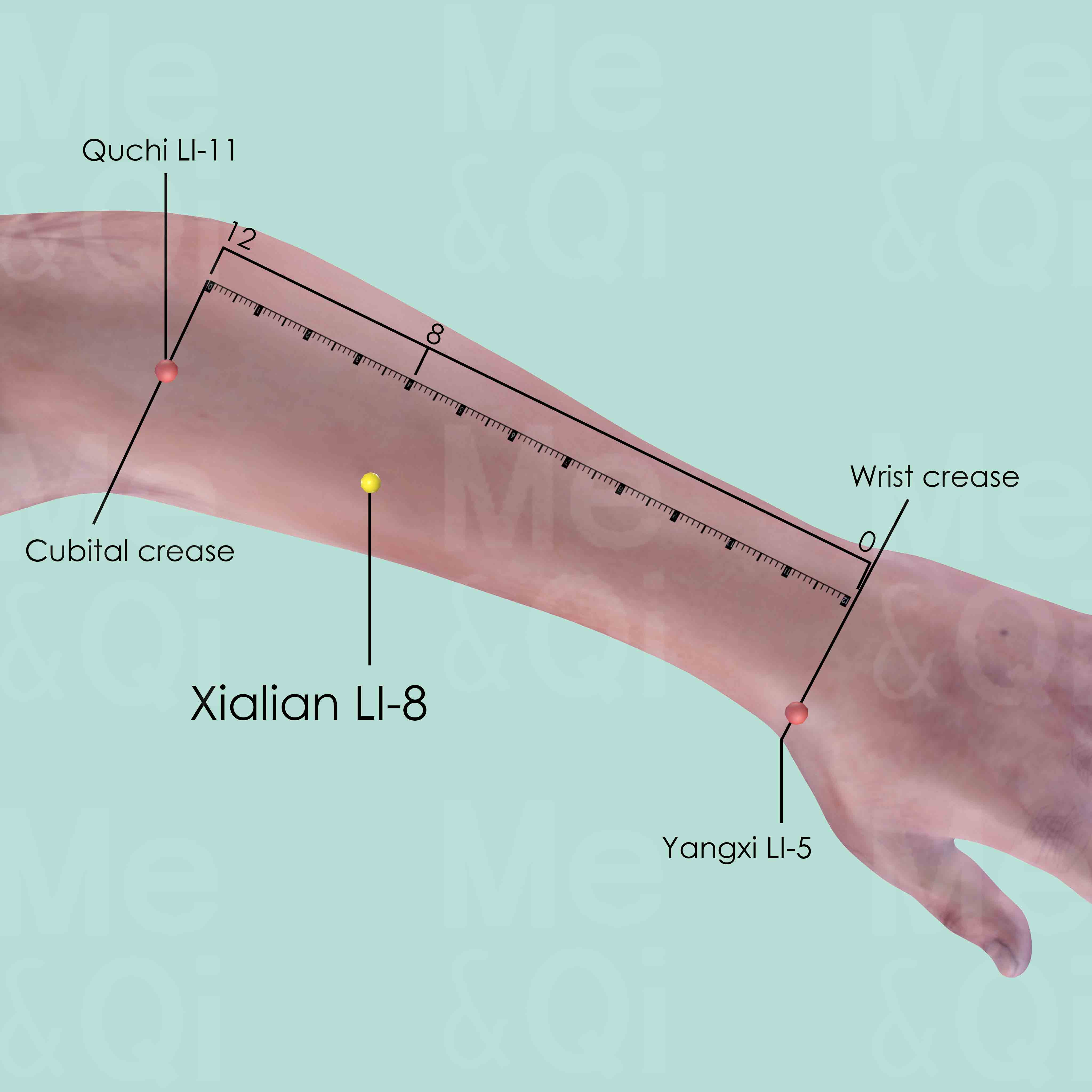
Xialian LI-8
When a fist is made, with the ulnar side downward and elbow flexed, the point is 4 cun distal to Quchi LI-11 of the line joining Yangxi LI-5 and Quchi LI-11.
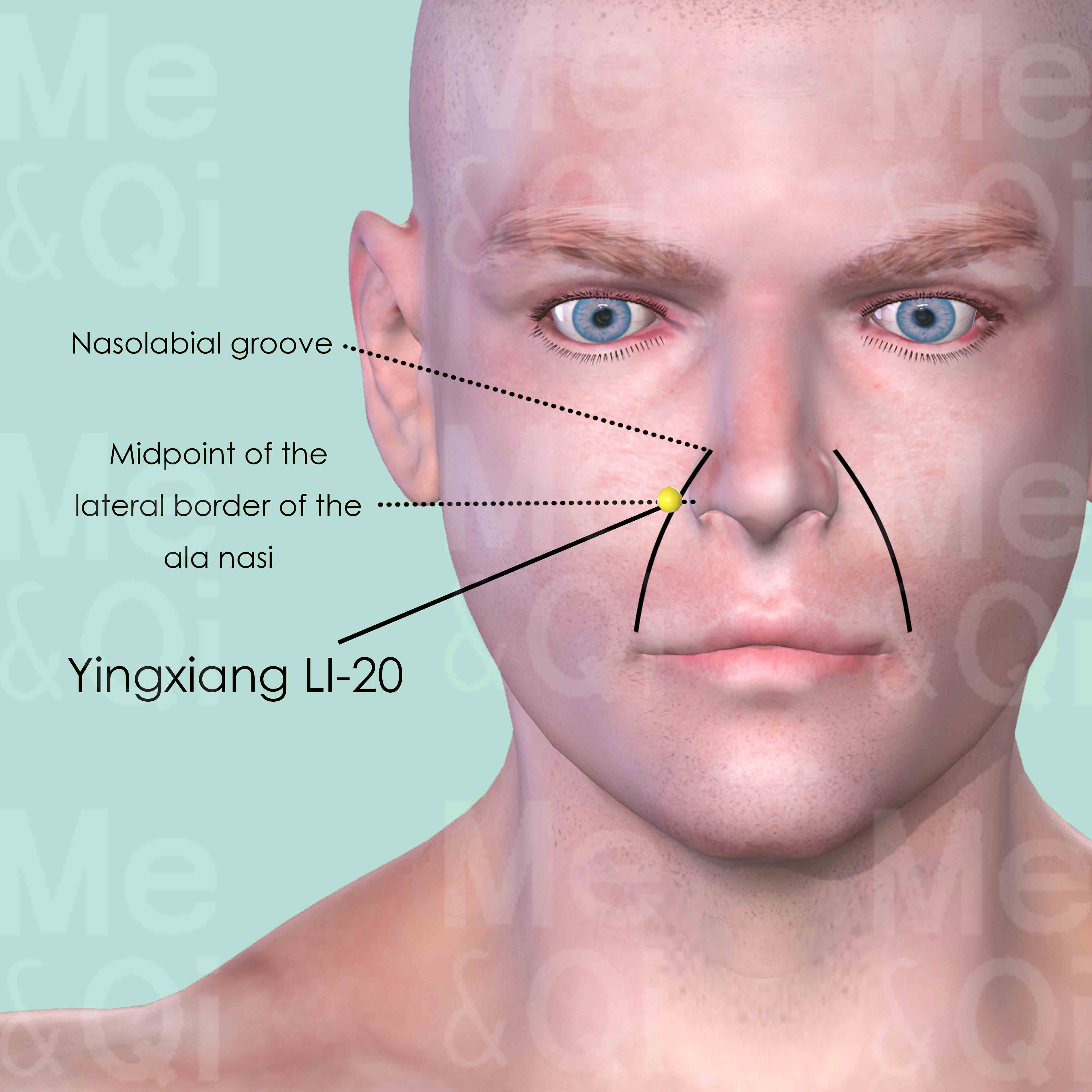
Yingxiang LI-20
In the nasolabrial groove, at the level of the midpoint of the lateral border of ala nasi.
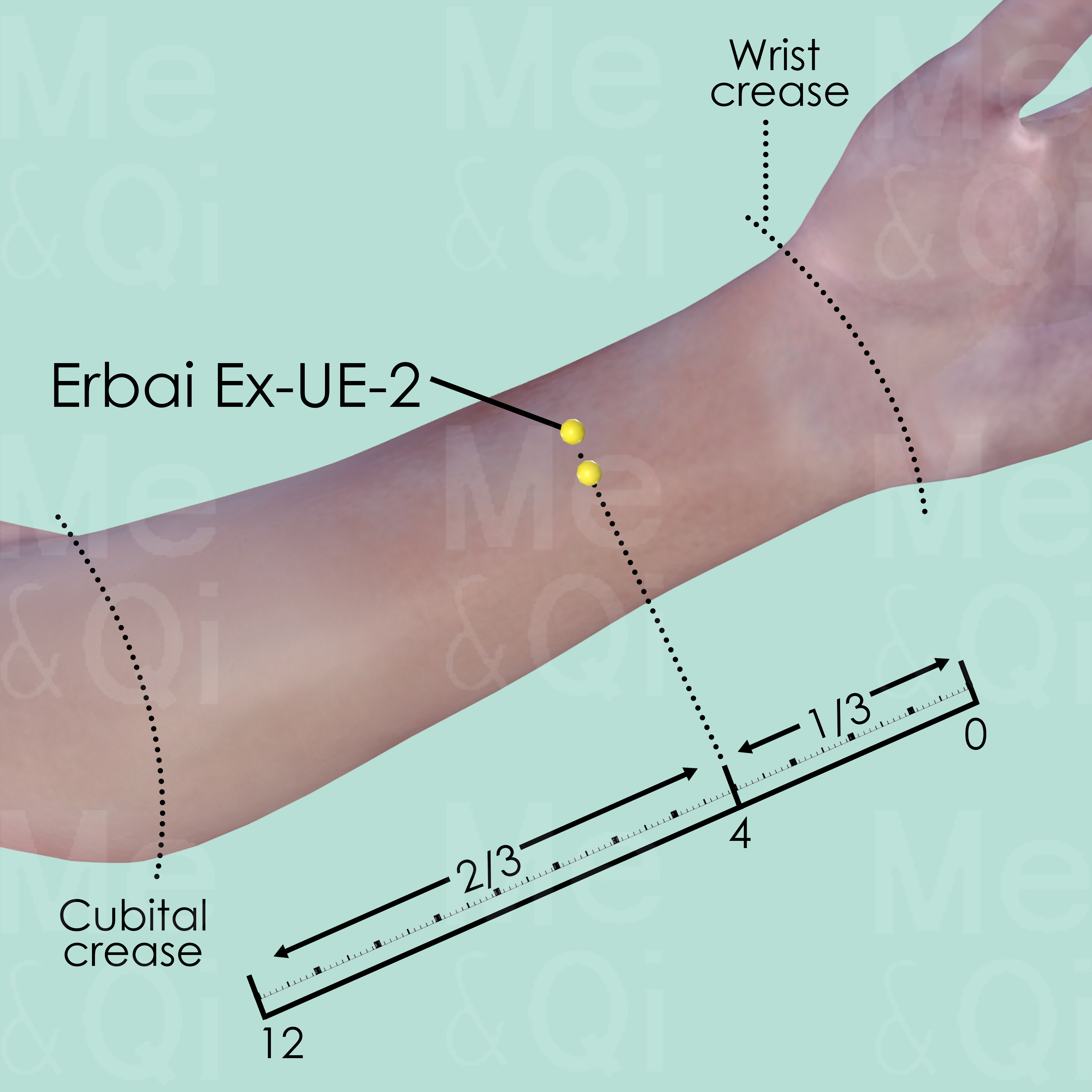
Erbai Ex-UE-2
A pair of points on the palmar aspect of the forearm, 4 cun proximal to the wrist joint space (most distal wrist crease), on either side of the tendon of the flexor carpi radialis muscle.
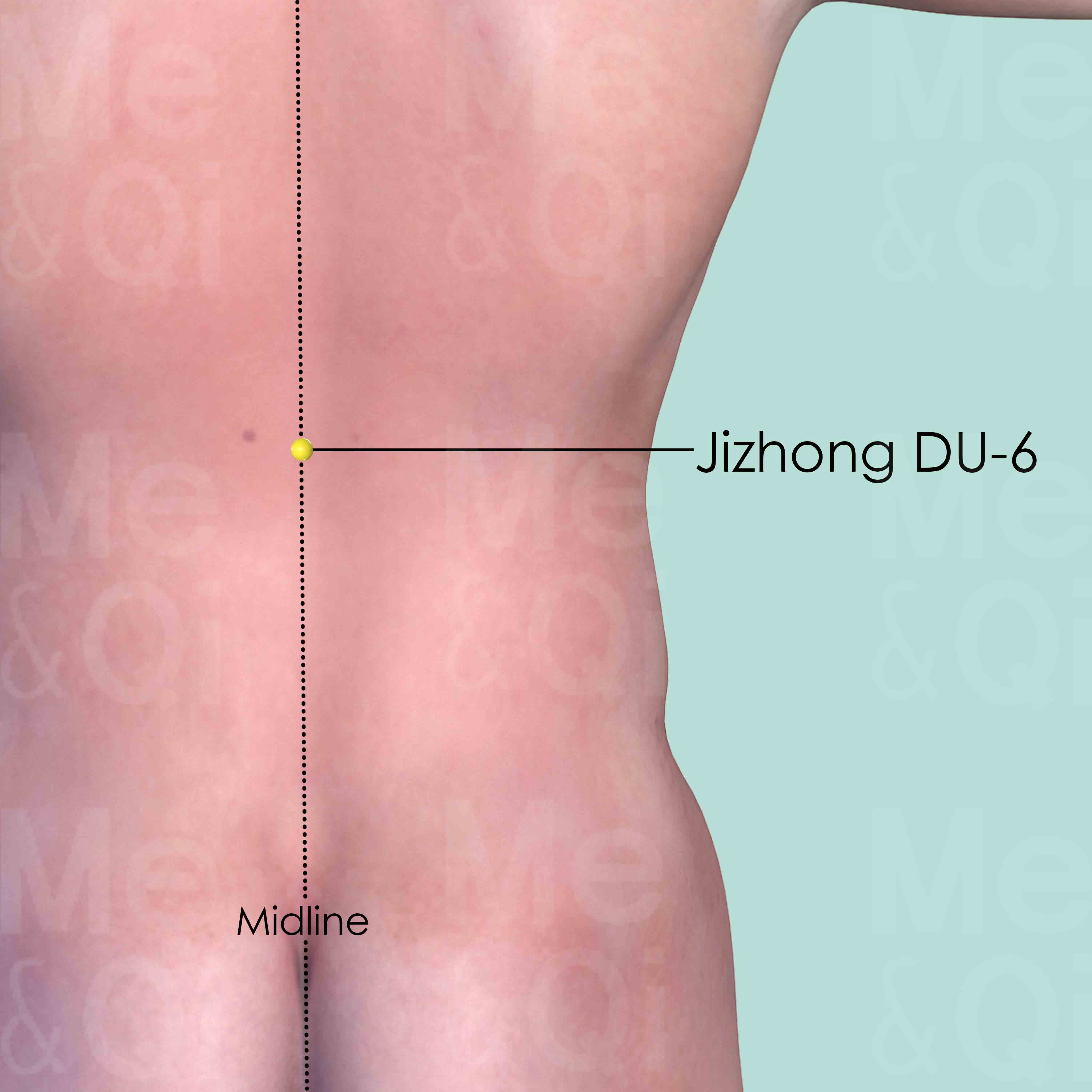
Jizhong DU-6
On the back midline, in the depression below the spinous process of the 11th thoracic vertebra (T11).

